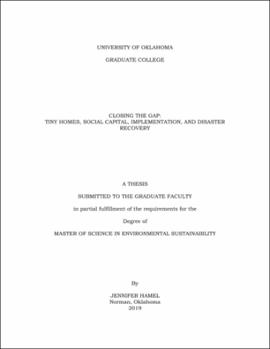| dc.contributor.advisor | Gliedt, Travis | |
| dc.contributor.author | Hamel, Jennifer | |
| dc.date.accessioned | 2019-05-09T13:36:31Z | |
| dc.date.available | 2019-05-09T13:36:31Z | |
| dc.date.issued | 2019 | |
| dc.identifier.uri | https://hdl.handle.net/11244/319647 | |
| dc.description.abstract | Over the last fifteen years, the United States has experienced an exceedingly high number of devastating hurricanes; these storms have affected the nation in ways that are still being examined and dealt with years after the last raindrop. The Federal Emergency Management Agency has responded to these catastrophes in many ways. The focus of this research is the handling of disaster relief housing by the United States government and how the decisions made have impacted the environment, society, and the economy. After a thorough analysis of the impacts of decisions made in the aftermath of some of the costliest hurricanes in American history, a more sustainable alternative is presented for the implementation of housing in the form of off-grid tiny homes, supporting a sanguine future for storm victims. | en_US |
| dc.language | en_US | en_US |
| dc.subject | disaster relief housing | en_US |
| dc.subject | social capital | en_US |
| dc.subject | tiny homes | en_US |
| dc.subject | off-grid housing | en_US |
| dc.title | CLOSING THE GAP: TINY HOMES, SOCIAL CAPITAL, IMPLEMENTATION, AND DISASTER RECOVERY | en_US |
| dc.contributor.committeeMember | Smith, Laurel | |
| dc.contributor.committeeMember | Warnken, Charles | |
| dc.date.manuscript | 2019 | |
| dc.thesis.degree | Master of Science in Environmental Sustainability | en_US |
| ou.group | College of Atmospheric and Geographic Sciences::Department of Geography and Environmental Sustainability | en_US |
